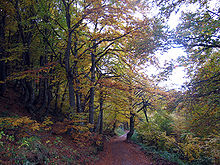 Mixed deciduous forest in Stara Planina, Serbia
Mixed deciduous forest in Stara Planina, Serbia Deciduous means "falling off at maturity" or "tending to fall off", and is typically used in reference to trees or shrubs that lose their leaves seasonally, and to the shedding of other plant structures such as petals after flowering or fruit when ripe. In a more general sense, deciduous means the dropping of a part that is no longer needed, or falling away after its purpose is finished. In plants it is the result of natural processes. Deciduous has a similar meaning when referring to animal parts, such as deciduous antlers in deer, or deciduous teeth, also known as baby teeth, in some mammals (including humans).
Botany
In botany and horticulture, deciduous plants, including trees, shrubs and herbaceous perennials, are those that lose all of their leaves for part of the year. This process is called abscission. In some cases leaf loss coincides with winter — namely in temperate or polar climates. In other parts of the world, including tropical, subtropical, and arid regions, plants lose their leaves during the dry season or other seasons, depending on variations in rainfall.
The converse of deciduous is evergreen, where green foliage is persistent year round. Plants that are intermediate may be called semi-deciduous; they lose old foliage as new growth begins. Other plants are semi-evergreen and lose their leaves before the next growing season, retaining some during winter or dry periods. Some trees, including a few species of oak, have desiccated leaves that remain on the tree through winter; these dry persistent leaves are called marcescent leaves and are dropped in the spring as new growth begins.
 Deciduous forest in winter
Deciduous forest in winterThe converse of deciduous is evergreen, where green foliage is persistent year round. Plants that are intermediate may be called semi-deciduous; they lose old foliage as new growth begins. Other plants are semi-evergreen and lose their leaves before the next growing season, retaining some during winter or dry periods. Some trees, including a few species of oak, have desiccated leaves that remain on the tree through winter; these dry persistent leaves are called marcescent leaves and are dropped in the spring as new growth begins.
 Like many deciduous plants, Forsythia flowers during the leafless season
Like many deciduous plants, Forsythia flowers during the leafless seasonMany deciduous plants flower during the period when they are leafless, as this increases the effectiveness of pollination. The absence of leaves improves wind transmission of pollen for wind-pollinated plants and increases the visibility of the flowers to insects in insect-pollinated plants. This strategy is not without risks, as the flowers can be damaged by frost or, in dry season regions, result in water stress on the plant. Nevertheless, there is much less branch and trunk breakage from glaze ice storms when leafless, and plants can reduce water loss due to the reduction in availability of liquid water during cold winter days.
 Deciduous forest in autumn
Deciduous forest in autumnLeaf drop or abscission involves complex physiological signals and changes within plants. The process of photosynthesis steadily degrades the supply of chlorophylls in foliage; plants normally replenish chlorophylls during the summer months. When autumn arrives and the days are shorter or when plants are drought-stressed, deciduous trees decrease chlorophyll pigment production, allowing other pigments present in the leaf to become apparent, resulting in non-green colored foliage. The brightest leaf colors are produced when days grow short and nights are cool, but remain above freezing. These other pigments include carotenoids that are yellow, brown, and orange. Anthocyanin pigments produce red and purple colors, though they are not always present in the leaves. Rather, they are produced in the foliage in late summer, when sugars are trapped in the leaves after the process of abscission begins. Parts of the world that have showy displays of bright autumn colors are limited to locations where days become short and nights are cool. In other parts of the world, the leaves of deciduous trees simply fall off without turning the bright colors produced from the accumulation of anthocyanin pigments.
 Mixed deciduous forest in spring
Mixed deciduous forest in spring
No comments:
Post a Comment